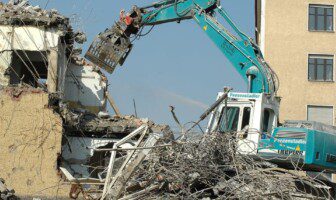
Commercial construction sites are busy places where important projects get built, and cities grow. While construction brings progress, it is also risky.
The large equipment, heavy materials, and constant movement mean these areas can be dangerous.
Construction consistently has more work-related deaths than many other jobs. In the UK, 2023/24 data showed that construction had the most work-related fatalities.
Keeping everyone safe is not only the right thing to do-it is required by law.
Common construction risks and accidents can slow down projects, lead to legal problems, increase costs, and harm a company’s reputation.
Taking strong safety steps is not just about following rules; it also creates a culture where everyone’s safety is at the core of every decision.
Whether you manage ground work, steel work, or coordinate skilled trades like a copper roofing contractor, putting safety first is always the smartest approach.
Here are the main steps that can make a construction site much safer for everyone.
What Are The Common Construction Risks?
Recognizing risks is the first part of making a safer workplace. You need to know what could go wrong to put the right protections in place.
1. Common Types Of Accidents In Construction
Many kinds of accidents can happen on a construction site. The most frequent and deadly are falls from heights.
In 2023/24, these caused many deaths at work. Other common accidents include slips, trips, and falls on the ground, often because of uneven surfaces, clutter, or bad housekeeping.
Workers can also be hurt by falling objects, moving vehicles, or getting caught in machinery. While not as common, electrocution is often deadly when it does happen.
Knowing about these dangers is the first step in stopping them.
2. Hazardous Materials And Substances
Workers may come into contact with dangerous substances, especially in older buildings where asbestos may be present, or when cutting stone or concrete and stirring up silica dust.
Chemicals like paints, adhesives, and solvents also pose risks, either by breathing them in, touching them, or from fire.
Always use safe storage, plenty of ventilation, and the right gear to handle these materials.
3. Equipment And Machinery Risks
Heavy tools and machines help get the job done, but they come with hazards. Machines without proper guards, tight spaces, getting crushed, and the massive weight of excavators or cranes can all cause injuries.
Workers must have full training, good habits, and know the site rules to avoid problems. Everyone needs to pay attention, especially around machinery, since it’s easy to end up in a blind spot.
3. Environmental And Site Hazards
The worksite itself can create risks, too. Weather- rain, wind, heat, or cold- affects site safety. Bumpy ground, nearby roads or utilities, noise, and wet floors all add to the hazards.
Wet locations need lower-voltage equipment (110V) and safety switches to lower the risk of electric shock.
How Are Common Construction Risks Spotted And Handled?
Good safety starts by looking for hazards before work begins and keeping an eye on them during the whole project.
1. Site Risk Assessment
Perform a risk assessment before starting major work and keep doing it as things change. Spot the dangers, figure out how likely and severe they would be, and decide what protection you need.
Workers should get a clear assessment for every job they do. So they know about the risks specific to their tasks.
2. Reporting Unsafe Conditions
Workers need to be able to point out and report hazards quickly. Every construction site should have a simple way to report problems, near misses, and anything unsafe.
Dealing with these issues fast can stop small problems from turning into big accidents. Encourage everyone to tell the site manager right away if they see anything dangerous.
3. Ongoing Hazard Checks
Things change on site all the time, even within a single day. Regular site inspections and safety checks help keep up with new dangers.
Workers should stay alert and keep watching out for new or changing risks. Quick reports and quick fixes help keep the site safe for everyone.
How To Control Site Access And Security To Avoid Common Construction Risks?
Managing who enters and where they go is key for safety on construction sites.
1. Controlling Who Comes And Goes
Only authorized people should enter a construction site. Use sign-in systems, security staff, and specific entry and exit points.
New workers must go through a full safety induction to understand the site risks, rules, and restricted areas. Visitors need safety briefings and should be supervised if needed.
2. Keeping People Out Of Dangerous Areas
Some site zones are much riskier, such as active demolition sites, excavations, and machine operation areas.
These parts must be clearly marked with barriers and warning signs. Only workers with the right training and equipment should enter. Never go into restricted areas unless you belong there.
How Training And Safety Meetings Help To Avoid Common Construction Risks?
Training keeps the site safe and helps prevent accidents.
1. Required Safety Training
Everyone on site must get health and safety training, as required by law. All new workers must take safety training at the beginning of their job.
This includes general rules, spotting hazards, and emergency steps.
Some jobs, such as working at height, with machines, or with chemicals, need extra, special training.
2. Toolbox Talks And Safety Meetings
Safety training is not a one-and-done thing- it needs regular reminders. That’s where “toolbox talks” come in. Hold these quick safety meetings every week or two.
Discuss current site risks, review emergency drills, and show correct equipment use. This helps keep safety top of mind and lowers accident rates.
Using The Right Personal Protective Equipment (PPE) To Avoid Common Construction Risks
It’s always best to prevent dangers at the source, but when that’s not possible, PPE is a must.
1. PPE For Different Construction Jobs
Employers must make sure workers use the right PPE for the job to reduce injuries. The PPE needed depends on what job you’re doing and where.
Hard hats, high-visibility vests, steel-toe boots, safety glasses, earplugs, gloves, and respirators are all needed in different situations. Some work calls for special gear.
2. PPE Condition And Fit
Providing PPE isn’t enough; it must fit right and be in good shape. Employers need to help workers pick the proper gear and check it often.
If it’s damaged or doesn’t fit, it could be useless or even unsafe. Workers should always look at their PPE before using it and report any problems.
3. Teaching How To Use PPE
Even the best gear does nothing if not worn properly. Teach workers how to put on, adjust, and take off PPE the right way.
They also need to know what their equipment does and what it can’t do. Know when to use each PPE item and how it fits in with other safety steps.
Good Habits With Tools And Equipment To Avoid Common Construction Risks

Machines and tools are necessary, but using them wrong is a major cause of accidents.
1. Inspection And Care
All equipment and tools must be checked, serviced, and repaired as the manufacturer recommends.
Frequently checking tools means you’re less likely to have an accident because of something that’s broken or not working right.
Before using anything, do a quick check of its condition.
2. Always Use The Right Tool
It sounds obvious, but always use the right tool for the job. Using the wrong tool can hurt the tool, the material, or the worker. If not sure, ask a supervisor.
In wet conditions or trades, use 110V tools instead of 240V to lower the shock risk.
3. Machine Safety And Lockout Rules
Many machines have built-in safety guards. Never remove these or try to get around them. If a machine needs repair, follow lockout/tagout instructions so it can’t turn on by mistake.
If something is broken, report it instead of trying to fix it yourself without proper training.
Preventing Falls: Main Guidelines
Since falls cause the most deaths in construction, preventing them must come first.
1. Barricades, Safety Nets, And Harnesses
Use maximum protection where possible. Guardrails and safety nets protect groups of people at once and require no special action.
If these can’t be used, workers must use proper harnesses attached to secure points. Make sure these are checked and fitted correctly every time.
2. Safe Work On Ladders And Platforms
When working from heights-scaffolds, ladders, and rooftops, make sure the support is set up right, secure, and on stable ground.
Never work in an area without guardrails or risk checks in place.
3. Height Work Training
Anyone working high up must get special training. This includes spotting height risks, using harnesses, knowing what to do in emergencies, and using the right safe work practices for different types of platforms.
This training is not optional, and it saves lives.
Why Housekeeping Matters For Safety And Avoiding Common Construction Risks?
Cleanliness and order stop countless accidents before they start.
1. Preventing Trips, Slips, And Falls
Messy sites lead to accidents. Tools left around, materials in walkways, and spills all make slips and trips more likely. Keep paths clear and tidy at all times.
2. Storing Materials And Disposing Of Waste
Store materials safely out of the way and keep waste in proper containers. Clean up loose materials and spills often.
Don’t let waste pile up, as it can trip workers or bring health problems and pests.
3. Clear Walkways And Emergency Routes
Always keep exits, stairs, and paths open and easy to use. This helps prevent injuries and ensures everyone can get out quickly if there’s an emergency.
Setting Up Emergency Plans And Procedures To Avoid Common Construction Risks
Emergencies happen even with the best precautions, so everyone must know what to do if one occurs.
1. Emergency Response Planning
Every site needs a written emergency plan. This should cover what to do in case of fire, a medical emergency, a chemical spill, collapse, or extreme weather.
Make sure everyone can see and access this plan.
2. Evacuation Routes And Meeting Points
Mark exit routes and safe meeting spots outside the danger zone. Train all workers to know these routes and what to do if they need to leave quickly during an emergency.
3. First Aid And Emergency Help
Sites must have trained first aid staff, fully stocked kits, and clear contact information. Workers should know who to call and what to do if someone gets hurt.
Practice emergency drills so everyone knows their job in a real emergency.
Why Clear Communication Keeps Sites Safe
Good communication keeps all safety plans working together and stops accidents before they happen.
1. Health And Safety Signs
Safety signs should be displayed in areas where there’s a risk. Use clear colors like red for dangers, yellow for warnings, blue for required actions, and green for safe conditions.
Make sure everyone knows what each sign means, and ask if they aren’t sure.
2. Incident Reporting
Have a system so workers can report accidents and near misses easily. Tracking these helps find problem areas and see where improvements are needed.
Make sure everyone knows how to report issues quickly by using forms, calls, or electronic systems.
3. Speaking Up For Safety
A safe workplace is one where workers are not afraid to mention unsafe practices or point out problems. Listen to their feedback, look into any reports, and show everyone that safety is the responsibility of all.
This attitude helps create a safe and confident team.
Working safely in commercial construction means being careful, staying informed, and making safety part of everything you do.
It’s about far more than just following the rules- it’s about looking after people.
With careful planning, regular training, solid communication, and a shared focus on safety, you can lower the risk of accidents and make sure everyone goes home healthy each day.
Putting safety first, every day, is the best way to protect the most important part of every construction site.
Read Also:




























